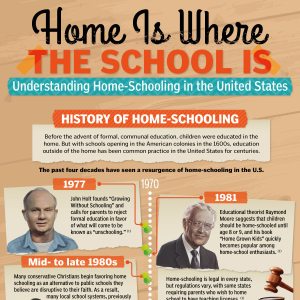Home Is Where the School Is: Understanding Home-Schooling in the United States
History of Home-Schooling
Before the advent of formal, communal education, children were educated in the home. But with schools opening in the American colonies in the 1600s, education outside of the home has been common practice in the United States for centuries.
The past four decades have seen a resurgence of home schooling in the U.S.
1977
John Holt founds “Growing Without Schooling” and calls for parents to reject formal education in favor of what will come to be known as “unschooling.” (1)
1981
Educational theorist Raymond Moore suggests that children should be home-schooled until age 8 or 9, and his book “Home Grown Kids” quickly becomes popular among home-school enthusiasts. (1)
Home schooling is legal in every state, but regulations vary, with some states requiring parents who wish to home school to have teaching licenses. (1)
Mid- to late 1980s
Many conservative Christians begin favoring home schooling as an alternative to public schools they believe are disruptive to their faith. As a result, many local school systems, previously friendly to the home-school movement, begin to feel threatened and less cooperative with home-schoolers. (1)
1999
About 850,000 students are home-schooled in the United States. By 2011, that number will grow to more than 1.7 million. (1)
Today
While in the 1980s, religion was a primary reason for parents to home-school, today that has changed, with fewer than 1 in 5 parents saying faith is the biggest reason why they home-school. (1)
State of Home Schooling
What is the picture of home-schooling today?
3.4%
Percentage of school-age children who are home-schooled (2)
Percentage of children home-schooled by year (3)
1999: 1.7%
2003: 2.2%
2007: 2.9%
2011: 3.4%
Ethnicity of home-schooled American children (3)
White: 68%
Black: 8%
Hispanic: 15%
Asian/Pacific Islander: 4%
Other: 5%
Home-schooled students per total school-age students by state (4)
North Carolina: 0.059
Indiana: 0.032
Alabama: 0.029
Alaska: 0.029
Arizona: 0.029
Arkansas: 0.029
California: 0.029
Colorado: 0.029
Connecticut: 0.029
D.C.: 0.029
Georgia: 0.029
Hawaii: 0.029
Idaho: 0.029
Illinois: 0.029
Iowa: 0.029
Kansas: 0.029
Kentucky: 0.029
Louisiana: 0.029
Maine: 0.029
Maryland: 0.029
Massachusetts: 0.029
Michigan: 0.029
Mississippi: 0.029
Missouri: 0.029
Montana: 0.029
Nebraska: 0.029
Nevada: 0.029
New Hampshire: 0.029
New Jersey: 0.029
New Mexico: 0.029
New York: 0.029
North Dakota: 0.029
Ohio: 0.029
Oklahoma: 0.029
Oregon: 0.029
Pennsylvania: 0.029
Rhode Island: 0.029
South Carolina: 0.029
South Dakota: 0.029
Tennessee: 0.029
Texas: 0.029
Utah: 0.029
Vermont: 0.029
Washington: 0.029
West Virginia: 0.029
Wyoming: 0.029
Florida: 0.026
Virginia: 0.022
Delaware: 0.021
Wisconsin: 0.02
Minnesota: 0.019
Reasons for home-schooling, percentage of parents citing reason (2)
Religious instruction: 64%
Moral instruction: 77%
Concern about environment of other schools: 91%
Dissatisfaction with academic instruction at other schools: 74%
Nontraditional approach to child’s education: 44%
Child has other special needs: 17%
Child has a physical or mental health problem: 15%
Other reasons: 37%
Home-schooled students typically score 15-30 percentile points higher than public school students on standardized tests. (5)
Getting Started: Tips for Home-Schooling Your Children
Interested in removing your children from regular school? Consider the following issues: (6, 7)
The law
Rules and regulations about home-schooling vary widely depending on where you live. Before you take any steps to remove your kids from school, be sure you know exactly what’s expected of you. Consult the Home School Legal Defense Association (http://www.hslda.org/), or your state’s home-school association.
Your approach
What methods will you use educate your children? Will the curriculum be highly structured? Will you allow your children to determine the course of their education?
Rely on community
With home-schooling growing in popularity, many options exist for finding networks of other parents who home-school.
Especially when you’re getting started, these resources can be invaluable for developing your teaching style or simply providing moral support when things get tough.
Set a space
While your child won’t be leaving the home for school, it’s important to create some sense of separation so that the tasks of schoolwork don’t become too intermingled into the household.
Establish expectations
Decide how you will evaluate your child’s progress in each subject and communicate that at the outset.
Don’t forget friends
The social aspect of formal education is sometimes neglected when children are home with their parents all day every day. Interaction and play with children outside the family is vital for social development.
Sources:
1. http://www.responsiblehomeschooling.org
2. http://www2.ed.gov
3. https://nces.ed.gov
4. http://a2zhomeschooling.com
5. http://www.nheri.org
6. http://www.pbs.org
7. http://school.familyeducation.com


